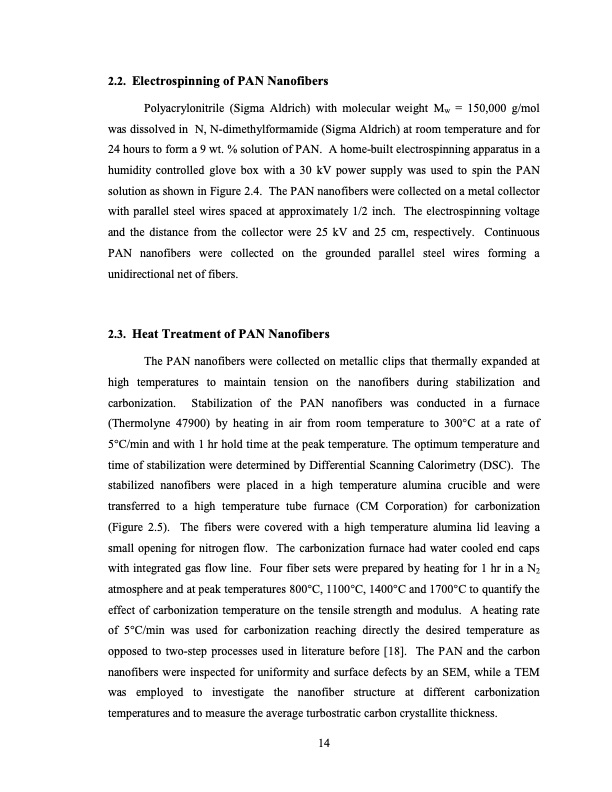
PDF Publication Title:
Text from PDF Page: 021
2.2. Electrospinning of PAN Nanofibers Polyacrylonitrile (Sigma Aldrich) with molecular weight Mw = 150,000 g/mol was dissolved in N, N-dimethylformamide (Sigma Aldrich) at room temperature and for 24 hours to form a 9 wt. % solution of PAN. A home-built electrospinning apparatus in a humidity controlled glove box with a 30 kV power supply was used to spin the PAN solution as shown in Figure 2.4. The PAN nanofibers were collected on a metal collector with parallel steel wires spaced at approximately 1/2 inch. The electrospinning voltage and the distance from the collector were 25 kV and 25 cm, respectively. Continuous PAN nanofibers were collected on the grounded parallel steel wires forming a unidirectional net of fibers. 2.3. Heat Treatment of PAN Nanofibers The PAN nanofibers were collected on metallic clips that thermally expanded at high temperatures to maintain tension on the nanofibers during stabilization and carbonization. Stabilization of the PAN nanofibers was conducted in a furnace (Thermolyne 47900) by heating in air from room temperature to 300°C at a rate of 5°C/min and with 1 hr hold time at the peak temperature. The optimum temperature and time of stabilization were determined by Differential Scanning Calorimetry (DSC). The stabilized nanofibers were placed in a high temperature alumina crucible and were transferred to a high temperature tube furnace (CM Corporation) for carbonization (Figure 2.5). The fibers were covered with a high temperature alumina lid leaving a small opening for nitrogen flow. The carbonization furnace had water cooled end caps with integrated gas flow line. Four fiber sets were prepared by heating for 1 hr in a N2 atmosphere and at peak temperatures 800°C, 1100°C, 1400°C and 1700°C to quantify the effect of carbonization temperature on the tensile strength and modulus. A heating rate of 5°C/min was used for carbonization reaching directly the desired temperature as opposed to two-step processes used in literature before [18]. The PAN and the carbon nanofibers were inspected for uniformity and surface defects by an SEM, while a TEM was employed to investigate the nanofiber structure at different carbonization temperatures and to measure the average turbostratic carbon crystallite thickness. 14PDF Image | HIGH STRENGTH CARBON NANOFIBERS DERIVED FROM ELECTROSPUN POLYACRYLONITRILE

PDF Search Title:
HIGH STRENGTH CARBON NANOFIBERS DERIVED FROM ELECTROSPUN POLYACRYLONITRILEOriginal File Name Searched:
4835609.pdfDIY PDF Search: Google It | Yahoo | Bing
Sulfur Deposition on Carbon Nanofibers using Supercritical CO2 Sulfur Deposition on Carbon Nanofibers using Supercritical CO2. Gamma sulfur also known as mother of pearl sulfur and nacreous sulfur... More Info
CO2 Organic Rankine Cycle Experimenter Platform The supercritical CO2 phase change system is both a heat pump and organic rankine cycle which can be used for those purposes and as a supercritical extractor for advanced subcritical and supercritical extraction technology. Uses include producing nanoparticles, precious metal CO2 extraction, lithium battery recycling, and other applications... More Info
| CONTACT TEL: 608-238-6001 Email: greg@infinityturbine.com | RSS | AMP |